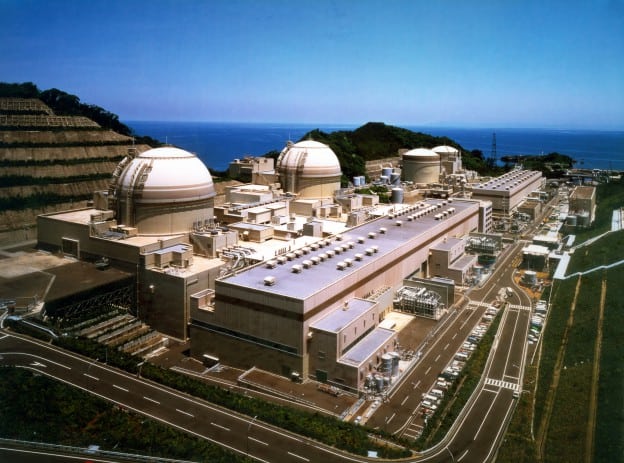Japan Looks at Ramping Up Nuclear Power to Ensure Energy Supply

Japan's prime minister said the country is prepared to restart more of its idled nuclear reactors, and look at building more power generation facilities with next-generation nuclear technology.
The comments from Prime Minister Fumio Kishida during an Aug. 24 news conference in Tokyo signal a shift in Japan's thinking about nuclear power after the country idled its reactors, and adopted more stringent safety standards before any reactor could restart, after a massive earthquake and tsunami caused a meltdown in March 2011 at the Fukushima Daiichi power plant.
Kishida on Wednesday said his country's government also would look at extending the life of existing reactors. Analysts have said it's in response to higher energy prices, in part due to Russia's invasion of Ukraine and its impact on global energy markets, and to help Japan meet its environmental goals.
A hydrogen energy project is helping revitalize the Fukushima region in Japan. Read this report from the July 2022 issue of POWER.
Japan in the years following the disaster at Fukushima turned to imports of liquefied natural gas (LNG) for much of its power production, and is now the world's largest buyer of LNG, much of it from the U.S., which ranks fifth among Japanese suppliers behind Australia, Malaysia, Qatar, and Russia, according to the International Trade Administration. Rising prices for the fuel, amid supply instability due to the Russian invasion, already led Japanese officials to say they were ready to ask households and businesses to cut back their use of natural gas as part of an energy conservation plan.
Energy ChallengeChuck Goodnight, a U.S.-based partner with Arthur D. Little who leads the U.S. Nuclear Energy team as part of the firm's global Energy & Utilities practice, told POWER that Japan's energy challenge is that it is an island nation with no grid interconnection with other countries, so it cannot import electricity-it must produce it at home. With a limited set of indigenous fuel supplies, nuclear energy had been a significant source of domestically produced energy in Japan, reaching as high as 30% of energy production, and with plans to ramp up to 40%."
Kishida last month said he had asked the country's energy minister to have at least nine nuclear reactors operating this winter amid the current energy crunch. Kishida on Wednesday said he told officials to have concrete" measures in place by year-end, and said he wanted the government to work on gaining the understanding of the public" on nuclear power and sustainable energy.
Wednesday's meeting comes as Japanese officials work on what's been called a green transformation" in the country, designed to help meet environmental goals. The government now sees nuclear power as a key part of that transformation, despite opposition to nuclear in the years after Fukushima, and continued concerns about how earthquakes could impact reactors. Officials have said that opposition is easing in the wake of higher energy prices.
Goodnight noted that Japan needs a lot of energy" to support its large population and its very large economy," considered the world's third-largest behind the U.S. and China. When combined with government plans to develop a green transformation,' Japan will need more low/no carbon reliable energy sources," Goodnight said.
Three-Pronged ApproachGoodnight said Japan's new strategy appears to be a three-pronged approach: bring more of the still-idle nuclear plants back online, potentially more than a dozen. Extend the lives of all currently operating and to-be-restarted nuclear plants by taking credit for each reactor's downtime since 2011. [And] look into new reactors that could extend their low/no carbon energy generation sources."
There were 54 operating nuclear reactors in Japan in early 2011-including four at Fukushima Daiichi-supplying about 30% of the country's electricity. Japan idled all 50 of its remaining nuclear units after the incident at Fukushima, which occurred when a 9.0-magnitude earthquake in March 2011 caused a massive tsunami that flooded the Fukushima Daiichi facility in the northeastern part of the country. The resulting release of radiation was the largest since the Chernobyl meltdown in Ukraine in 1986.
The government recently said 10 nuclear reactors at six power stations in Japan have been given the go-ahead to restart, but just seven reactors are currently in operation, in part due to the time required to implement new safety measures and complete other construction work. The government has said 21 reactors have been decommissioned since Fukushima.
Kishida on Wednesday also said the government was exploring ways to extend the lifespan of existing reactors. Japan historically has said nuclear plants would be decommissioned after 60 years of service. Moving forward, though, reactors that have been offline over the past several years would not have those years included in their service time.
This is a policy shift since 2011, with a renewed focus on nuclear energy as a key element of Japan's energy supply," said Goodnight. As a result, I predict Japan will slowly move to restart all of its existing reactor fleet, extend the lives of all of the reactors, and move toward new reactors to expand the low/no carbon generating portfolio. Those new reactors will likely be a combination of small modular reactors [SMRs] and advanced reactors, both of which will have improved safety profiles compared to the existing Gen II and Gen III/III+ reactors."
-Darrell Proctor is a senior associate editor for POWER (@POWERmagazine).
The post Japan Looks at Ramping Up Nuclear Power to Ensure Energy Supply appeared first on POWER Magazine.